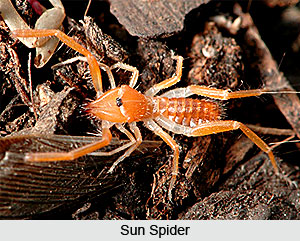 Sun Spiders are also known as False Spiders. They differ from all other arachnids in having a pair of armed (chelate) jaws, a body divided into a head, a three-segmented thorax and a ten-segmented abdomen - which give them a close resemblance to insects. The pedipalps are long, leg-like and locomotory. The pedipalps and legs are hairy and with spines, giving the animal a dangerous appearance. There are two simple eyes on the head. They possess poison glands at the base of the jaws but are not poisonous to man. They breathe by air tubes like insects.
Sun Spiders are also known as False Spiders. They differ from all other arachnids in having a pair of armed (chelate) jaws, a body divided into a head, a three-segmented thorax and a ten-segmented abdomen - which give them a close resemblance to insects. The pedipalps are long, leg-like and locomotory. The pedipalps and legs are hairy and with spines, giving the animal a dangerous appearance. There are two simple eyes on the head. They possess poison glands at the base of the jaws but are not poisonous to man. They breathe by air tubes like insects.
Like spiders, Sun Spiders are dimorphic - the male being much thinner and smaller than the female. Mating is fraught with danger to the males but their small size helps them to escape quickly from being devoured by the hungry females. Sun Spiders are nimble and keen-sighted. They are fast and powerful hunters, overtaking and capturing any beetle, locust, moth or even a small lizard that comes in sight. Their formidable jaws crush the prey to small particles which they swallow. They are fearless of human beings - for they freely crawl over tea-shop tables to catch flies and suck up drops of water or tea adhering to mugs and glasses.
Sun Spiders are widely distributed in the sandy regions of all warm countries. Eggs are laid by the female in holes which she digs in sand or soil with her jaws. The eggs hatch in a fortnight. After another fifteen days they begin to moult and become small Sun Spiders. The mother keeps guard over them until they can forage for themselves.
The term, `Sun Spiders`, is a misnomer having regard to the fact that many of them are nocturnal. A few species however roam about in the bright sun and the Spaniards called them aranhas del sol or `Sun Spiders`, which name has come to stay. The common genera found in India are Galeodes and Rhagodes.











